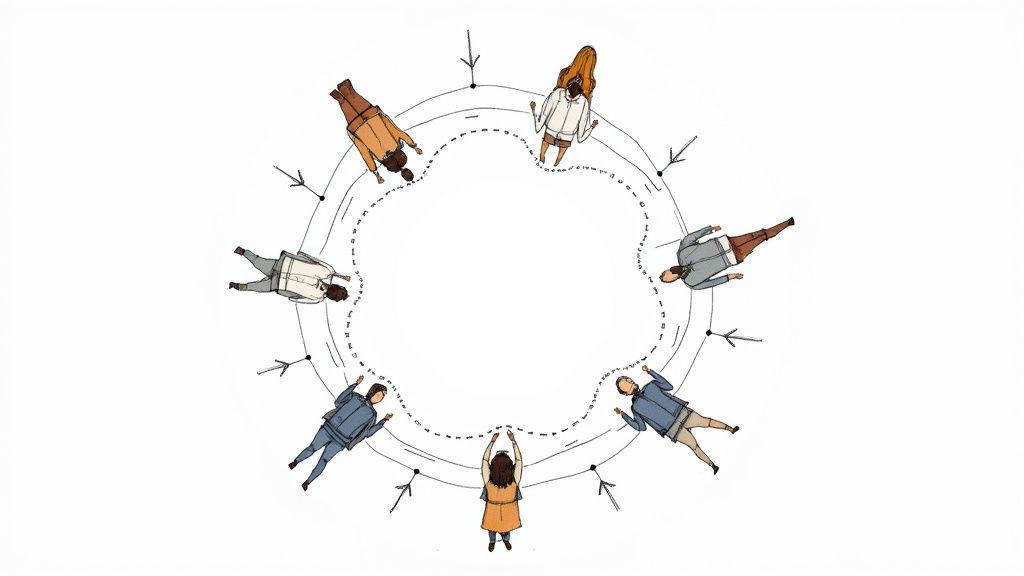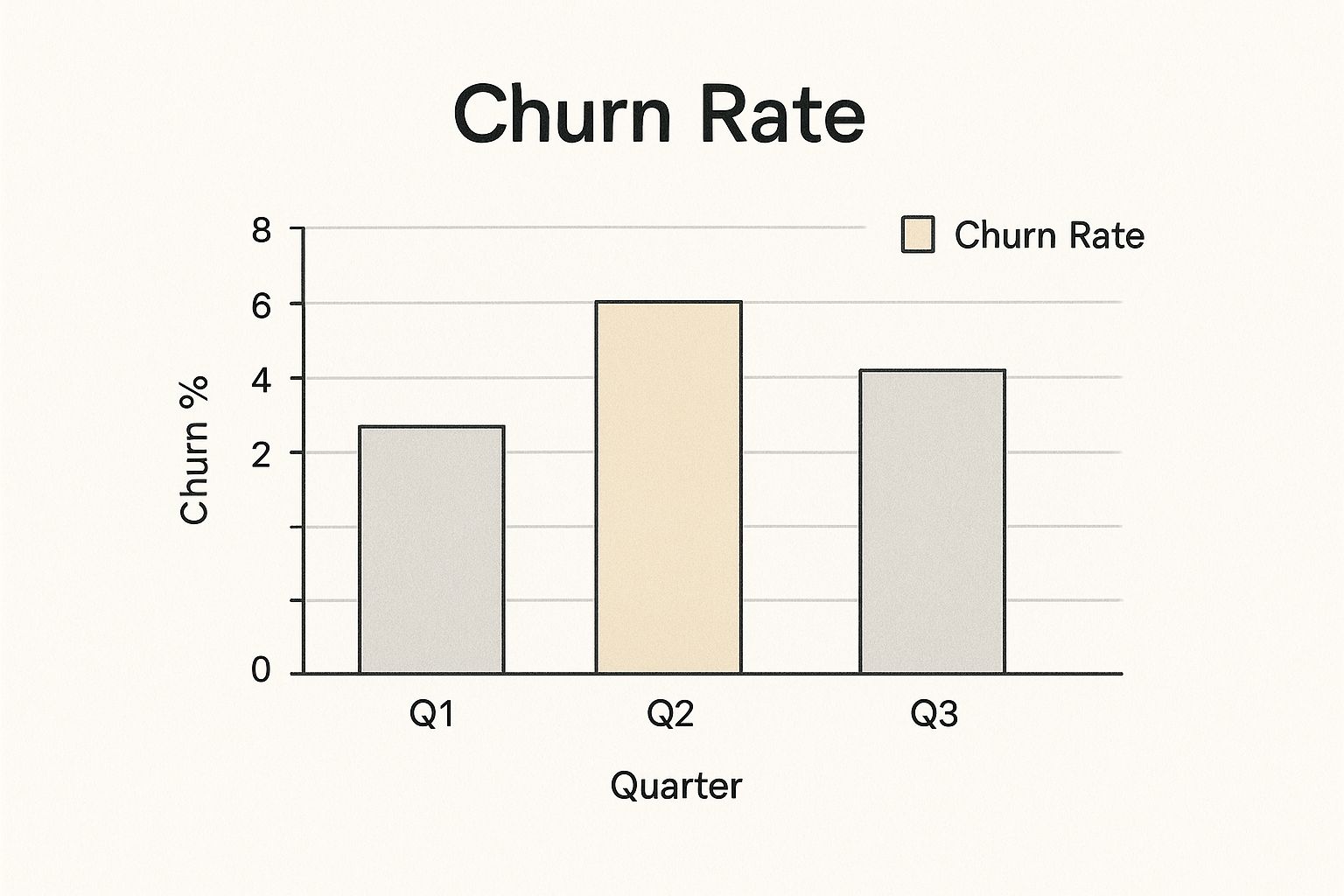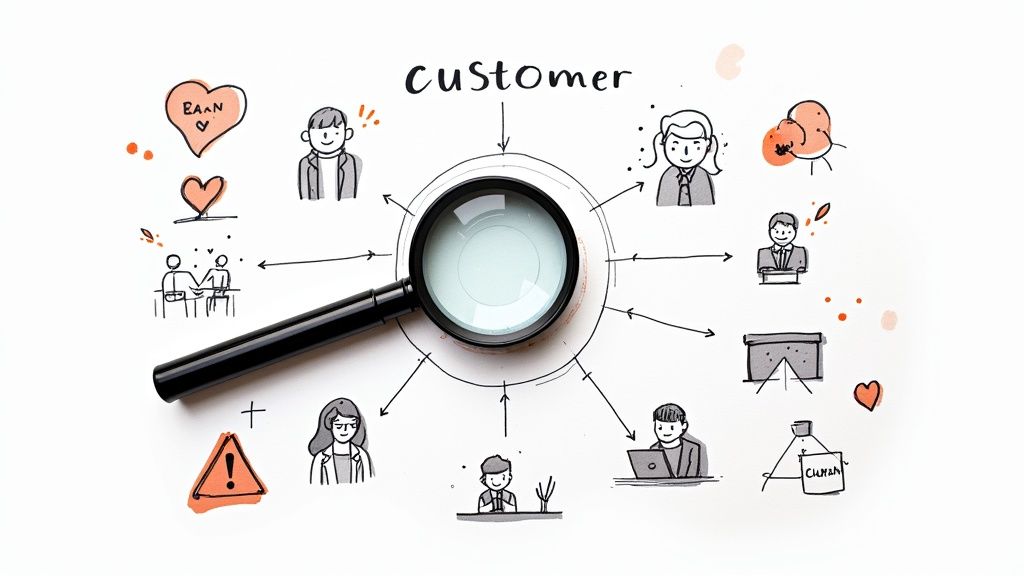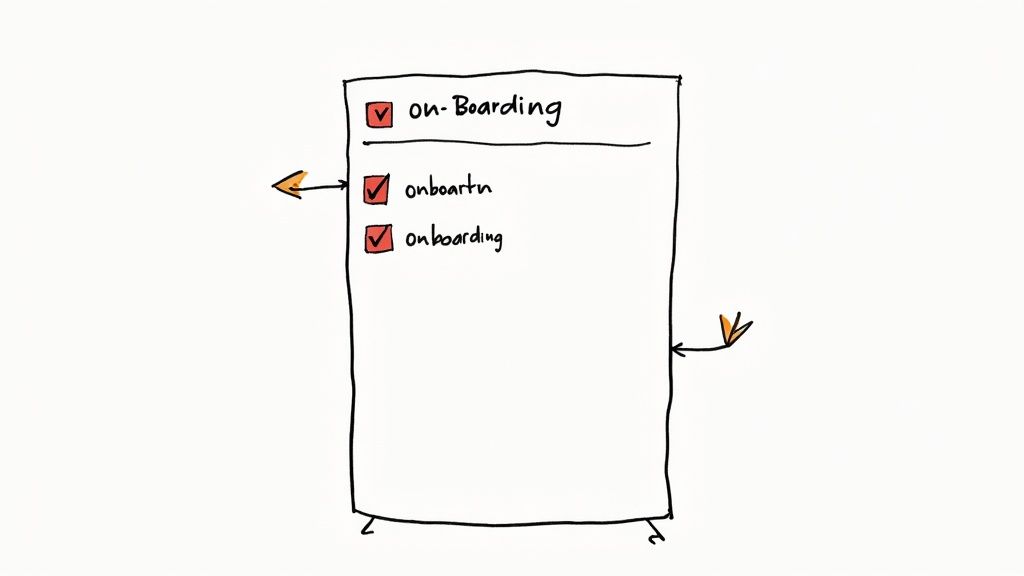August 17, 2025

Let's get straight to the point: member churn is a silent killer for communities. If you want to stop the bleeding, you need a solid game plan. It's really a three-pronged attack: proactively engaging members before they start to fade, delivering personalized value that makes your community indispensable, and building feedback loops that prove you're actually listening. This isn't a one-and-done task; it's a constant cycle of listening, acting, and reinforcing your community's value.
Churn is so much more than a number on a spreadsheet. It’s the pulse of your community, telling you exactly how healthy it is and how much value you’re providing. It’s the percentage of members who decide to walk away over a certain period. But the real danger isn't just the people who hit "cancel."
The quiet disengagement is what should keep you up at night. These are the members who stop logging in, stop participating, and eventually, stop seeing the point. This slow fade is insidious because it often goes unnoticed. Before you realize what's happening, a chunk of your community has gone silent, making the space feel empty and jeopardizing future renewals for everyone else.
Thinking a "small" churn rate is no big deal is a massive oversight. That seemingly minor monthly percentage compounds into a major problem over the year, steadily eroding your member base. A monthly churn of just 5% might not sound alarming, but it translates into losing nearly 46% of your members annually.
Let's look at how quickly this adds up.
This table demonstrates how a small monthly churn rate can lead to significant annual member loss, highlighting the importance of proactive retention.
As you can see, even a seemingly low rate can hollow out your community over time. It's a stark reminder that what happens month-to-month has a huge long-term impact.
Churn isn't just about lost revenue. It’s a loss of momentum, a loss of your biggest advocates, and a loss of the shared knowledge that your members bring to the table. Every person who leaves takes a small piece of your community's network effect with them.
This is a real-world look at how churn can fluctuate, which is why constant monitoring is so crucial.

The data makes it clear that churn isn't a static problem. It ebbs and flows with market shifts, new community initiatives, and member sentiment. Your retention strategy has to be just as agile. For a deeper dive into this, there are some proven strategies to reduce churn rate and cultivate customer loyalty that are worth a read.
Getting new members through the door is always exciting, but keeping the ones you've already won is way more efficient and profitable. Building that kind of loyalty takes real, dedicated effort focused on delivering consistent, undeniable value. This goes way beyond a simple welcome email. It's about truly understanding what your members need to be successful.
To make this happen, you need ongoing programs that build connections and repeatedly prove your community's worth. Success here is never an accident. It comes from deliberate and thoughtful community engagement strategies.
Ultimately, the goal is to create an ecosystem so valuable and interconnected that leaving feels like taking a step backward in one's career. You want to make retention the natural result of an amazing member experience.

Before you can even think about fixing churn, you have to play detective. Trying to boost retention without understanding why people are leaving is like treating a cough without knowing if it's from a cold or something more serious. You might see a temporary fix, but the real issue will still be there, quietly undermining your community.
Every community is different. The reasons your members leave can be anything from a fuzzy value proposition to a clunky user experience. The first step is to stop guessing and start digging. You need to build a clear, data-driven picture of what's really going on, blending the hard numbers with human stories.
Your investigation should start with the behavior of members who have already left. The goal here is to find the breadcrumbs they left behind—the patterns of disengagement that showed up long before they hit the "cancel" button. This is where a platform like GroupOS becomes your best friend, centralizing all that member activity into a single, analyzable feed.
Zero in on a few key engagement metrics to spot the trends:
Analyzing this data lets you build a profile of an "at-risk" member. For example, you might discover that a member who doesn't attend an event or post anything within their first 45 days is a staggering 70% more likely to churn within their first year. That single insight is gold—it gives you a specific, proactive target for your retention efforts.
Numbers tell you what is happening, but they rarely tell you why. To get to the heart of your churn problem, you have to talk to people. This is where you’ll uncover the actionable, human insights that data alone will never give you.
Don’t be afraid of exit feedback. Every departing member offers a free consultation on how to improve your community. The most painful feedback often leads to the most powerful improvements.
There are two fantastic ways to gather this crucial information: exit surveys and one-on-one interviews. Each plays a unique role in your diagnostic toolkit.
An exit survey is your first line of defense for getting feedback quickly and at scale. The key is to keep it short and sweet. A long, complicated survey will get ignored every time. Your only goal is to find out the main reason they're leaving with as little friction as possible.
Here are a few high-impact questions I've found work well:
The responses will help you start bucketing your churn drivers. You might find that 40% of churn is due to "budget constraints," while 30% is chalked up to "not enough networking opportunities." This kind of segmentation is essential for figuring out where to focus your energy first.
For high-value members or when you spot a trend that really worries you, nothing beats an actual conversation. A simple 15-minute chat can provide more context than hundreds of survey forms. It shows you genuinely care and gives you the invaluable opportunity to ask follow-up questions.
When you get on the call, approach it with genuine curiosity, not defensiveness. Thank them for their time and their past contributions. Then, try some open-ended questions like these:
Just listen. Take detailed notes. You’ll often uncover subtle issues that a survey could never capture—things like a culture mismatch, a frustrating onboarding process, or a key feature that's hard to find. When you combine these stories with your quantitative data, you'll finally have a complete diagnosis of your churn problem, paving the way for a solution that actually works.

This screenshot from GroupOS gives you a glimpse into the kind of member activity data that should be informing your strategy. When you know what resonates, you can create more of the experiences that make people want to stick around.
Once you’ve figured out why people are leaving, it’s time to shift gears from reactive analysis to proactive prevention. The single best way to slash your churn rate is to build a community so valuable and interconnected that leaving feels like a genuine career misstep. This isn't about occasional check-ins; it's about embedding your community into the daily professional routines of your members.
A proactive approach means creating consistent, valuable touchpoints that reinforce why they joined in the first place. You need to keep that connection alive to spot problems early and show your value long before a member even thinks about leaving.
Let's be honest: the first 30 to 90 days make or break a member's long-term commitment. This is your window to either hook them for the long haul or lose them to apathy. A killer onboarding process doesn't just welcome people—it guides them straight to that "aha!" moment where they experience the core value of your community firsthand.
Your entire goal is to help them feel successful, and fast. A single welcome email won't cut it.
One-size-fits-all content is a recipe for boredom and, ultimately, churn. To keep members showing up, you have to deliver experiences that hit on their specific interests and career goals. This is where segmenting your community with a tool like GroupOS becomes so powerful.
Picture a developer community that notices its junior members are churning at a higher rate. Instead of guessing, they dive into the engagement data and see that these members are ghosting the advanced technical discussions.
Real-World Scenario: A professional marketing group used member interest tags to launch an expert "Ask Me Anything" (AMA) series. They brought in specialists for weekly sessions on SEO, content marketing, and paid ads. This targeted approach didn't just feel relevant—it drove a 40% increase in weekly participation and became a core part of their retention strategy.
This kind of programming shows you're not just broadcasting content; you're listening and responding to what your members actually need.
While your official events and content are the foundation, the most durable communities are built on a dense web of member-to-member relationships. When people build real friendships and professional alliances, the community's value skyrockets. Your job is to be the catalyst for those connections.
Think about implementing programs specifically designed to forge these bonds:
These tactics transform your community from a simple content hub into a vibrant professional ecosystem. For a deeper look at similar principles, many of these ideas are echoed in proven student retention strategies, which also center on engagement and connection. By focusing on creating value through relationships, you build a powerful defense against churn. Our own guide on https://groupos.com/blog/member-engagement-strategies offers even more ideas to get you started.
Nothing kills a community faster than a generic, one-size-fits-all experience. When every member gets the same notifications, the same content, and the same event invites, things start to feel impersonal, fast. It’s the quickest way to get members asking, "Is this community really for me?" And once that question pops up, they’re already halfway out the door.
The key is to make every single member feel seen and understood, even as you scale from 100 to 10,000 members. This isn't about memorizing everyone's birthday. It's about strategically using member data to deliver real value that’s tailored to them, proving you get what they need at their specific point in their career.
To really nail personalization, you have to dig deeper than just job titles and company names. The real magic happens when you start understanding member behavior—what they do, what they click on, and what they ignore. This means pulling together data from all over your community to build a living, breathing profile for each person.
This is exactly what platforms like GroupOS are designed for. They act as a central hub, letting you see everything a member does, from the moment they sign up to their latest comment.
I've found that focusing on a few key data points gives you the most bang for your buck:
With this kind of insight, you can stop guessing and start making targeted moves that actually reduce your churn rate.
Once you’ve got the data, segmentation is how you bring it to life. Instead of shouting the same message to everyone, you can create smaller, more focused groups and talk to them about things they actually care about.
Let's say you run a community for software engineers. Sending a blast notification about a "new event" is just noise. But with smart segmentation, that noise becomes value.
Here’s a real-world example: You can create segments based on career level. Send an invite for an upcoming "Mentorship Q&A" only to your junior developer segment. At the same time, you can send a personal invitation for an "Exclusive Leadership Roundtable" only to your senior and principal engineers.
This approach is powerful for two reasons. First, members only get information that’s immediately relevant to them. Second, it makes them feel like the community was built just for them. That kind of tailored experience is incredibly hard to walk away from.
Not all personalization strategies are created equal. Some are quick wins, while others are bigger projects. Understanding the effort versus the potential reward helps you prioritize what to tackle first. Here’s a quick breakdown I often use to map out a plan.
As you can see, even low-effort tactics can have a meaningful impact, but the high-effort strategies are often what create truly dedicated, long-term members.
While data and segmentation are your tools for scaling, never forget the impact of a simple, human connection. These are the moments that build genuine loyalty and make your community feel like a real community, not just another online platform.
A quick, personal DM from a community manager can work wonders. Acknowledge a great point someone made in a discussion. Congratulate them on a new role they shared. Ask for their thoughts on a recent event they attended.
These small, manual actions prove there are real people behind the curtain who are paying attention. It's a well-known fact that customers leave when they feel ignored or unappreciated. In a community, these personal touches are your best defense against that feeling. They build an emotional bond that makes clicking "cancel membership" a whole lot harder.

It’s time to stop thinking of member feedback as a passive suggestion box and start treating it as your single most powerful weapon against churn. An active feedback loop isn't just about collecting comments; it's a living, breathing system that proves you're listening and, most importantly, taking action.
This process transforms members from passive observers into active co-creators of your community, building an incredible sense of ownership and loyalty along the way.
When people feel heard, they stick around. It’s that simple. Customer experience is everything when it comes to shrinking churn, and the data backs it up. In fact, a staggering 74% of customers report feeling more loyal when they believe a brand understands them. This shows that retention is often built on emotional connection, not just transactional value.
If you want a real feedback loop, you need consistent, reliable ways to gather input. Relying on random DMs or the occasional complaint means you're only hearing from the loudest voices—not the quiet majority who might be slowly disengaging and heading for the exit.
A structured approach ensures you capture the full picture. Here are a few methods I’ve seen work wonders:
Collecting feedback is just the price of entry. The real magic happens when you close the loop—when you go back to your members and show them what you’ve done with their input.
This is the step that builds massive trust and makes people feel genuinely valued. If you skip it, your feedback efforts will feel hollow and can actually make things worse.
A closed feedback loop is the ultimate proof that your community isn't a monologue—it's a dialogue. When members see their suggestions come to life, they transition from being passive consumers to active, invested partners in the community's success.
Let's walk through a real-world scenario. Imagine a few members mention in your suggestions channel that they're having a hard time finding old webinar recordings.
Here’s exactly how to handle that and close the loop like a pro:
That final, personal touch is what turns a potential critic into your biggest fan. By following this process every single time, you build a culture where feedback is not only welcome but visibly acted upon—creating one of your strongest defenses against churn.
For more ideas on keeping your members engaged, check out our guide to the top membership retention strategies.
Even with a solid plan, you're going to have questions about churn. It's just the nature of running a community—you're always juggling high-level strategy with the daily grind. Let's dig into some of the most common questions I hear from community managers and get you some straight, practical answers.
Getting a handle on these details is what separates a reactive approach from a proactive one, and it's key to keeping your churn rate down for the long haul.
This is the million-dollar question, isn't it? The honest answer is, there's no single magic number. You'll see industry benchmarks thrown around—for many B2B SaaS companies, an "acceptable" annual churn rate is somewhere in the 5-7% range. But professional communities are a different beast, and so much depends on your model: free, freemium, or fully paid.
Instead of getting hung up on an industry average, focus on your own trend line. Is your churn rate this quarter lower than it was last quarter? That’s what real progress looks like. A "good" churn rate is one that's consistently dropping because of the retention work you're putting in.
The most important benchmark is your own past performance. Aim for steady, incremental improvement month over month. That’s a far more powerful indicator of a healthy, growing community than trying to match an arbitrary industry standard.
Consistency is everything, but the right rhythm depends on your community's size and sales cycle. For most professional communities I've worked with, checking in monthly is the sweet spot.
Here’s how to think about the two most common approaches:
My advice? Track it monthly, but report on it quarterly. This gives you the best of both worlds. You get the agility to respond to immediate problems and the perspective to make smart long-term decisions without overreacting to minor blips.
You absolutely can. Churn is rarely a surprise event. It’s almost always a slow fade, and it leaves behind a trail of breadcrumbs in your data. By tracking member engagement, you can build a profile of what an "at-risk" member looks like and step in before they hit the cancel button.
Think of it as an early-warning system for your community. You’re just looking for signals that a member is drifting away and no longer seeing value.
Some of the most reliable predictors I've seen are:
By setting up alerts in a platform like GroupOS, you can get a notification the moment a member's behavior fits this at-risk profile. This lets you proactively send a personal message, offer some help, or invite them to an event you know they’d love. This hands-on approach is fundamental. For a deeper dive into actionable methods, check out these proven strategies to reduce customer churn.
Ready to turn these insights into action? With GroupOS, you can track member engagement, identify at-risk users, and personalize your outreach all in one place. Stop guessing why members leave and start building a community they’ll never want to part with.


